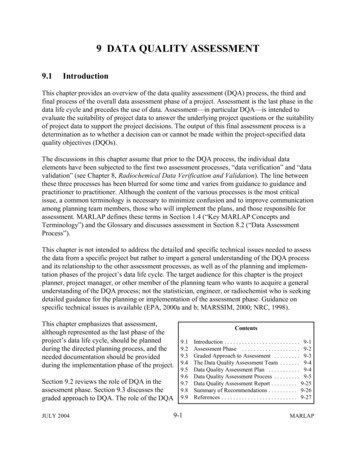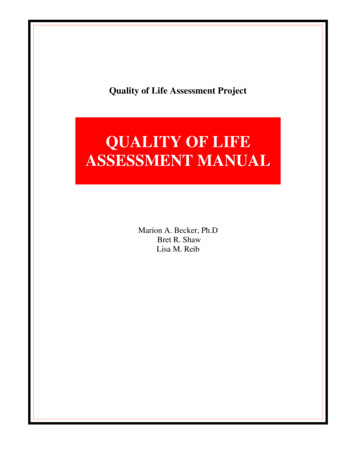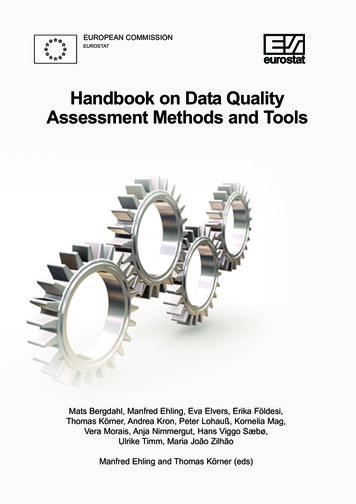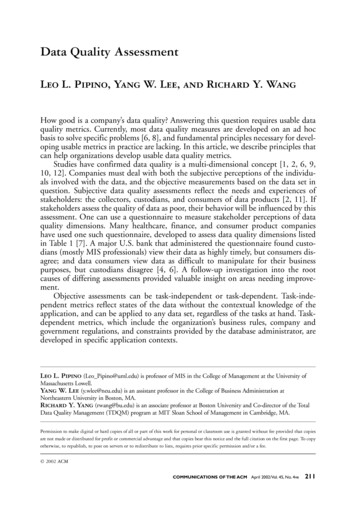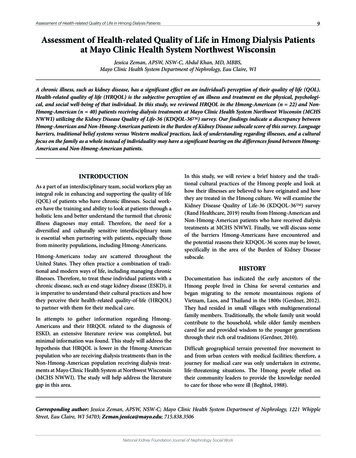
Transcription
9Assessment of Health-related Quality of Life in Hmong Dialysis PatientsAssessment of Health-related Quality of Life in Hmong Dialysis Patientsat Mayo Clinic Health System Northwest WisconsinJessica Zeman, APSW, NSW-C, Abdul Khan, MD, MBBS,Mayo Clinic Health System Department of Nephrology, Eau Claire, WIA chronic illness, such as kidney disease, has a significant effect on an individual’s perception of their quality of life (QOL).Health-related quality of life (HRQOL) is the subjective perception of an illness and treatment on the physical, psychological, and social well-being of that individual. In this study, we reviewed HRQOL in the Hmong-American (n 22) and NonHmong-American (n 40) patients receiving dialysis treatments at Mayo Clinic Health System Northwest Wisconsin (MCHSNWWI) utilizing the Kidney Disease Quality of Life-36 (KDQOL-36TM) survey. Our findings indicate a discrepancy betweenHmong-American and Non-Hmong-American patients in the Burden of Kidney Disease subscale score of this survey. Languagebarriers, traditional belief systems versus Western medical practices, lack of understanding regarding illnesses, and a culturalfocus on the family as a whole instead of individuality may have a significant bearing on the differences found between HmongAmerican and Non-Hmong-American patients.INTRODUCTIONAs a part of an interdisciplinary team, social workers play anintegral role in enhancing and supporting the quality of life(QOL) of patients who have chronic illnesses. Social workers have the training and ability to look at patients through aholistic lens and better understand the turmoil that chronicillness diagnoses may entail. Therefore, the need for adiversified and culturally sensitive interdisciplinary teamis essential when partnering with patients, especially thosefrom minority populations, including Hmong-Americans.Hmong-Americans today are scattered throughout theUnited States. They often practice a combination of traditional and modern ways of life, including managing chronicillnesses. Therefore, to treat these individual patients with achronic disease, such as end-stage kidney disease (ESKD), itis imperative to understand their cultural practices and howthey perceive their health-related quality-of-life (HRQOL)to partner with them for their medical care.In attempts to gather information regarding HmongAmericans and their HRQOL related to the diagnosis ofESKD, an extensive literature review was completed, butminimal information was found. This study will address thehypothesis that HRQOL is lower in the Hmong-Americanpopulation who are receiving dialysis treatments than in theNon-Hmong-American population receiving dialysis treatments at Mayo Clinic Health System at Northwest Wisconsin(MCHS NWWI). The study will help address the literaturegap in this area.In this study, we will review a brief history and the traditional cultural practices of the Hmong people and look athow their illnesses are believed to have originated and howthey are treated in the Hmong culture. We will examine theKidney Disease Quality of Life-36 (KDQOL-36TM) survey(Rand Healthcare, 2019) results from Hmong-American andNon-Hmong-American patients who have received dialysistreatments at MCHS NWWI. Finally, we will discuss someof the barriers Hmong-Americans have encountered andthe potential reasons their KDQOL-36 scores may be lower,specifically in the area of the Burden of Kidney Diseasesubscale.HISTORYDocumentation has indicated the early ancestors of theHmong people lived in China for several centuries andbegan migrating to the remote mountainous regions ofVietnam, Laos, and Thailand in the 1800s (Gerdner, 2012).They had resided in small villages with multigenerationalfamily members. Traditionally, the whole family unit wouldcontribute to the household, while older family memberscared for and provided wisdom to the younger generationsthrough their rich oral traditions (Gerdner, 2010).Difficult geographical terrain prevented free movement toand from urban centers with medical facilities; therefore, ajourney for medical care was only undertaken in extreme,life-threatening situations. The Hmong people relied ontheir community leaders to provide the knowledge neededto care for those who were ill (Beghtol, 1988).Corresponding author: Jessica Zeman, APSW, NSW-C; Mayo Clinic Health System Department of Nephrology, 1221 WhippleStreet, Eau Claire, WI 54703; Zeman.jessica@mayo.edu; 715.838.3506National Kidney Foundation Journal of Nephrology Social Work
10National Kidney Foundation Journal of Nephrology Social Work, Volume 45, Issue 1The Hmong people had endured decades of war trauma (Lee, 2019), most notably during the Vietnam War(Gerdner, 2010). After the United States withdrew troopsfrom South Vietnam in 1973, neighboring Laos also cameunder Communist control (Reznik, Cooper, MacDonald,Benador, & Lemire, 2001). During that time, thousands ofHmong fled the war zones in both countries and crossedthe dangerous Mekong river looking for safety in Thailand(Cobb, 2010). Large refugee camps were built in Thailand toprovide shelter for these people (Gerdner, 2010).change in their sociocultural environment resulted in drasticmisunderstandings between Western medical practices andthe traditional Hmong immigrants’ belief system (Helsel,Mochel, & Bauer, 2004). Compared to other refugee orimmigrant groups in U.S. history, the Federal Office ofRefugee Resettlement identified older Hmong immigrantsas having the greatest difficulty adjusting to American life.This has been compounded by language barriers, low socioeconomic status, lack of formal education, social isolation,and lack of transportation (Gerdner, 2010).The living conditions in these camps were horrific; many people succumbed to illness and death. Many elder Hmong recallappalling tales about physical and psychological trauma theyendured during the ongoing wars and as refugees (Gerdner,2010). Chronic malnutrition, lack of medical care, and lack ofpreventative medicine were common. Anemia was prevalent,mostly due to poor diet and parasite infections. Lice andscabies were widespread due to the proximity of the livingquarters and lack of sanitary conditions (Beghtol, 1988).THE CULTUREMistrust began to build between the Hmong and theU.S. government in the early 1970s. Even though manyyoung Hmong men and boys had fought in support of theAmerican troops, the U.S. government thought the Hmongpeople were “too primitive” to be given asylum at the endof the war. Initially, only prestigious Hmong leaders wereallowed to enter the United States. This caused resentmentamong many Hmong people towards the United States.Through ongoing advocacy efforts, the Hmong leaders wereable to solidify help for Hmong refugees still living in Laosand Thailand to enter the United States (Lee, 2019).In 1976, the Indochina Migration and Refugee AssistanceAct was passed. This allowed the Hmong people to begin theresettlement process to the United States (Lee, 2019). From1976 to 1997, over 100,000 Hmong people emigrated to theUnited States. The last of the large refugee camps in Thailandclosed in 1997, with an additional camp in Thailand relocating an additional 15,000 Hmong people to the U.S. in 2006(Gerdner, 2010). The vast majority of Hmong people fromthe refugee camps settled in California, Wisconsin, andMinnesota (Johnson, 2002).Hmong immigrants had difficulty understanding life inAmerica. In Laos, the Hmong people had little knowledge ofurban living, thus their transition to the U.S. was abrupt andtraumatic (Lor, Xiong, Park, Schwei, & Jacobs, 2017). Theindustrial U.S.'s technology was much more advanced thanmany had ever known (Beghtol, 1988).The Hmong people encountered barriers to communication,as well as understanding the American culture, community values, and expectations. This was most evident in thehealthcare system (Johnson, 2002). Adapting to enormousThe Hmong culture remains patriarchal in structure andis grouped into clans providing social structure (Xiong etal., 2016). There are 18 different family clans, determinedby ancestral lineage; each clan has its own history, which isshared oral stories passed down through generations fromtheir elders (Stratis Health, 2018).In the Hmong culture, men and women typically have verydistinct roles within the family structure. Traditionally themen and clan leaders make decisions about an individual’shealth—the individuals themselves do not make the decisions (Xiong et al., 2016). The clan leaders and other influential family members discuss the medical issues at hand andmake decisions for an individual, based upon what best suitsthe clan as a whole (Carteret, 2012).By tradition, the Hmong people have strong family bonds,based on a system of interdependence. Marriage and havinglarge families are highly valued in Hmong culture (PinzonPerez, 2006). The birth of children is proof of the families’worth within the clan and, in accordance with their traditional belief system, an indication that the spirits are not angrywith the family (Reznik et al., 2001). To this day, it remains acurrent practice to have multiple generations live in the samehouse for social and financial support (Gerdner, 2010).THE TRADITIONAL BELIEF SYSTEMThe traditional Hmong people practice animism, the beliefthat spirits live on, in, and around the human body. A balance between the body and spirit is required for good health(Xiong et al., 2016). Life is seen as a continuous cycle of birthand rebirth with two worlds—the physical and spiritual—coexisting side by side (Plotnikoff, Numrich, Wu, Yang, &Xiong, 2002). The Hmong believe that death is not the end,but rather the beginning of a new cycle in the reincarnation process; souls exist in the physical world indefinitely(Pinzon-Perez, 2006).LANGUAGEHaving a chronic medical illness as a Hmong person hasbeen an overwhelming experience for the thousands whoNational Kidney Foundation Journal of Nephrology Social Work
11Assessment of Health-related Quality of Life in Hmong Dialysis Patientsemigrated from Laos and Thailand to the U.S. (Lor etal., 2017). The words “chronic illness” do not exist in theHmong language. Therefore, it is a concept that is difficult todescribe to a Hmong person (Xiong et al., 2016).of Western medical providers to explain a prognosis (Rezniket al., 2001).The Hmong language was not a written language until thelate 1960s, when Christian missionaries developed a writingsystem to allow translation of the Bible; thus, the Hmonglanguage does not include modern-day medical terms(Carteret, 2012). Words such as “diabetes,” “hypertension,”and “cancer” are nonexistent, and the physical symptomsof these illnesses are often understood as an imbalance, adisruption of the souls or spirits, or coming from evil occurrences in former lives (Plotnikoff et al., 2002).Illness is defined by an individual’s understanding of theprocess, cause, severity, and prognosis of the disease. Allcultures have a belief system about the cause, diagnosis, andtreatments of diseases (Reznik et al., 2001). Western medicine is typically focused on germ theory and biomedicalphenomena. In comparison, many Non-Western culturesbelieve an illness is caused by an object intrusion, spirit possession, soul loss, or a breach of a taboo. The Hmong believein the integrity of the physical body, that body parts whichare cut or mutilated in accidents, surgery, or autopsy, willremain that way in reincarnation (Reznik et al., 2001).In a culture with (until recently) no written language andminimal medical terminology in its oral language, manyHmong-Americans may lack the ability to understand anddescribe the human body. They may have always relied ontraditional Hmong practices for support. The underlyingreason for a delay in seeking early or preventative healthcarewas often due to the lack of knowledge about illnesses anddiseases (Vang, 2019).Because most Hmong-Americans have significant respectfor healthcare providers, they will commonly say “yes” ornod in agreement during conversations; this does not meanthey agree with what is being said but are merely acknowledging the words being spoken to them. Elder HmongAmericans are often accustomed to speaking in metaphorsand telling a story to answer a question, even when askeddirectly by healthcare providers about specific symptoms(Carteret, 2012). This stems from their rich oral traditionsand storytelling practices, dating back hundreds of years.Many Hmong-Americans do not communicate dissatisfaction regarding the quality of their healthcare; instead, theywill simply go elsewhere. They often do not feel comfortableasking questions and speaking up. Hmong-Americans mayalso listen attentively to healthcare providers but will oftenavoid eye contact (Carteret, 2012). These types of behaviorsmay be a cause for misunderstanding between healthcareproviders and Hmong people. This misunderstanding anddistrust can also stem from unfamiliarity with commonpractices in Western healthcare, leading to delays in seekingmedical care, and poorer health outcomes.Many Hmong-Americans also distrust medications prescribed for health issues they cannot see and often stop taking medications once they feel better because they believethe illnesses have been cured, even if that is not true (Xionget al., 2016).Many Hmong-Americans believe talking about a disease orhearing about bad outcomes may mean they are asking forthe illness to occur, often contrary to the common practiceILLNESSESMany Hmong-Americans describe an illness as the inabilityto get up and fulfill their daily activities (Reznik et al., 2001).When traditional Hmong-Americans decide from whoor where to seek medical care for an illness, they start byevaluating the symptoms. Many feel that lack of energy andtiredness are caused by spirit loss, soul loss, or evil spirits, soa shaman is often utilized before Western healthcare providers are sought (Lor et al., 2017).They also may believe if there are no symptoms, then theillness is cured and no longer a problem. They often basetheir beliefs on prior experiences—if an individual in theirclan has been cured or healed by a certain treatment, thenthat treatment is taken into consideration by the clan leadersfor healing the next person with similar symptoms (Rezniket al., 2001).Once the clan leaders have diagnosed illness in an individualrequiring help, a plan is developed for that individual by theclan leaders. They may choose to treat the illness with shaman ceremonies, herbal medicines, Western medicines, or acombination. If all else fails, that individual may be taken tothe hospital; however, this was a very uncommon practice inLaos and Thailand (Beghtol, 1988).In the traditional Hmong culture, it is believed that manyillnesses are often associated with an underlying spiritualproblem (Wong, Mouanoutoua, Chen, Grey, & Tseng, 2005).Spiritual diseases occur when one or more of the humansouls or spirits become separated from the human body.A soul can become compromised in one of three ways(Gerdner, 2012): An evil spirit may invade or attach itself to aperson’s body. An evil spirit takes a person’s spirit and tortures it. The person’s soul becomes dissatisfied with thecurrent host body and leaves.National Kidney Foundation Journal of Nephrology Social Work
12National Kidney Foundation Journal of Nephrology Social Work, Volume 45, Issue 1Souls can be separated from a person by accident, by afrightening event, or be taken by an angered spirit. If thisoccurs, the soul loss can be experienced as pain, illness,or misfortunes (Reznik et al., 2001). A shaman is the onlyhealer who can communicate with the supernatural spiritsand bring back the soul (Lor et al., 2017). The role of theshaman is to perform a spiritual ceremony to recall thatsoul, using ritual practices. These Hmong healers bridgethe gap between the spirit world and the physical world tohelp resolve illnesses and bring back the good spirits to theperson with the illness (Xiong et al., 2016). Other times, ashaman might say they cannot see a spiritual issue causingthe illness, or it is too late to intervene, or it is too difficultto catch the wandering soul (Helsel, Mochel, & Bauer, 2004).It is widely believed that if the shaman’s rituals are unable tobring back the lost soul, that individual will only get worseand die (Pinzon-Perez, 2006). The desired outcome from theshaman is to promote and maintain spiritual harmony andbalance (Gerdner, 2012).CHRONIC ILLNESSMany Hmong-Americans, especially elders, focus on treating the illness but do not have an understanding of preventative medicine or of chronic diseases requiring dailytreatments, even when symptoms are not present (Carteret,2012). The Hmong language is very challenged in providingthe words to explain this concept.In Laos, the Hmong did not have access to modern medicineor educational opportunities to learn about the complexities of the human body. Many Hmong were unaware of theorgans within the human body and what purposes thoseorgans serve. Describing this phenomenon has become evenmore of a challenge due to the Hmong language’s lack ofwords to do so (Johnson, 2002). In the present day, whenhealthcare providers attempt to explain a disease or illnessaffecting a particular organ or body part, the HmongAmerican person is at a loss to understand what that means(Johnson, 2002). For example, some Hmong-Americanpeople believe that hypertension is caused by “bad blood,”and diabetes is caused by personal stress or a change in theweather (Lor, 2018).Common chronic health issues in the Hmong populationinclude hypertension, diabetes, kidney disease, and gout.The perception of not feeling “sick” has prevented HmongAmericans from seeking medical care or preventative measures, as well as not following prescribed medications oftenneeded for chronic illnesses (Vang, 2019). Multiple studieshave looked at health risks and disease prevalence in theHmong culture and suggest that Hmong-Americans havehigher rates of these illnesses than Caucasians (Lor, 2018).Many Hmong-Americans have difficulty understanding andresponding to chronic metabolic diseases, including diabetesand hypertension (common precursors for ESKD), for several reasons (Gerdner, 2010): A Hmong-American may overlook symptoms fromhealth insufficiencies for several years, delaying treatment. There are very few words in the Hmong language thatdirectly relate to these health issues. Hmong-American people often view their health aseither “black or white.” To be healthy requires a “balance.” Those suffering from illnesses have attributedthem to “imbalances” in souls or the spirit world. Western medications are “too strong,” and herbalmedicines are often the preferred choice.Lifelong illnesses require lifelong work to manage and control them. Such diseases can be marginalizing, isolating, andshaming for Hmong-American people. In a culture and family system that revolves around the group as a whole, insteadof individuality, being set apart from the group to manage achronic illness can feel overwhelming and painful (Helsel,Mochel, & Bauer, 2005). This can be especially difficult forchronic illnesses that have no immediate cure or that cannot necessarily be seen by others. These feelings can have adirect connection to the Hmong-Americans’ HRQOL.QUALITY OF LIFE (QOL)This study examines the HRQOL of Hmong-Americanpatients compared to Non-Hmong-American patients whohave chronic kidney failure requiring dialysis treatments inthe same period.Health, as defined by the World Health Organization(WHO), is a state of complete physical, mental, and socialwell-being, and not merely the absence of disease (Saad etal., 2015). Measuring quality of life (QOL) is essential whenassessing a patient’s perception of their health and is especially important for those who have a chronic illness. Healthrelated quality of life (HRQOL) is the subjective perceptionof the disease, its treatment, and its effect on the physical,psychological, and social well-being of an individual (Saadet al., 2015).Research has indicated a plethora of explanations affectinghealth outcomes for Hmong-Americans, including the lackof medical attention, communication misunderstandings,unfamiliarity with standard practices in Western healthcare, and cultural aspects. This conglomeration of multifactorial issues may lead to the low reported HRQOL byHmong-American patients. Research has also shown thatNational Kidney Foundation Journal of Nephrology Social Work
13Assessment of Health-related Quality of Life in Hmong Dialysis Patientslow HRQOL is a predictor of increased hospitalizations andmortality rates in this population (Schatell & Witten, 2012).Table 2. Comorbidities of Patient n100%97.5%Diabetes50%52.5%Cardiac-related issues50%82.5%Gout22.7%25%HYPOTHESISHRQOL is lower in the Hmong population receiving dialysistreatments than the Non-Hmong population receiving dialysis treatments at MCHS NWWI.METHODThe study proposal was reviewed and approved by MayoClinic institutional review board.ParticipantsWe reviewed the charts of 22 Hmong-American patientsreceiving dialysis treatments between November 2008 andNovember 2019. Nineteen patients were first-generationHmong-Americans, and three patients were second-generation Hmong-Americans.As a comparison group, 40 Non-Hmong-American patientswere randomly selected from a total of 331 Non-HmongAmerican patients from this same period (see Table 1).Table 1. Demographics of Patient SamplesHmongAmericansNonHmongAmericansNumberof patients2240Age range28–7726–93Mean age5868MaleFemale55%45%57%43%English asprimary language36%100%All 62 patients receive or have received care at MCHSNWWI, a subsidiary of Mayo Clinic. MCHS NWWI hasfour dialysis centers: Eau Claire Luther Hospital inpatient/outpatient services, Eau Claire London Road out-patientservices, Menomonie outpatient services, and Barron outpatient services. For our study’s purposes, the Barron outpatient dialysis center was not included due to a lack ofparticipants at this location.ComorbiditiesWe reviewed electronic medical records of our patients tocompare four chronic comorbid conditions (see Table 2).This data suggests similarities between Hmong-Americanand Non-Hmong-American patients regarding hypertension, diabetes, and gout prevalence. The biggest differencebetween these two groups showed a higher rate of cardiacrelated issues in the Non-Hmong-American patients ascompared to Hmong-American patients.MeasuresFor patients with ESKD and requiring dialysis treatments,the Centers for Medicare and Medicaid Services (CMS) hasintegrated HRQOL measures, and mandates dialysis facilities to perform routine administration utilizing a HRQOLscale (Chow & Tam, 2014). The KDQOL-36 survey is usedto meet these requirements (Cohen, Lee, Sibbel, Benner,Brunelli, & Tentori, 2019).The KDQOL-36 survey used in this study was derived fromthe original 134-item KDQOL instrument, the 79-itemKDQOL Short-Form survey, and the Medical OutcomesStudy 12-item Short-Form survey. A 36-question survey wasdeveloped measuring HRQOL for patients receiving ESKDtreatments (Peipert, Bentler, Klicko, & Hays, 2018). TheKDQOL-36 survey is the preferred measurement tool fordialysis facilities because of its ease of administration withminimal burden on patients and staff to complete and score,while providing an adequate assessment of the patient’s quality of life (Thaweethamcharoen et al., 2013).The KDQOL-36 is used with people over age 18, receivingdialysis treatments for more than three months, with thosewho do not have cognitive impairments such as dementia oractive psychosis, and is not used with non-English speakerswhen a translation is not available. According to the DialysisOutcomes and Practice Patterns Study (DOPPS), this surveyhas proven reliable and valid for measuring patient perceptions of their health-related quality of life (Schatell & Witten,2012).The KDQOL-36 is divided into five distinct subscales,all measuring different aspects of quality of life: Physical,Mental, Burden of Kidney Disease, Symptoms and Problems,and Effects of Kidney Disease on Daily Life (Schatell &Witten, 2012).National Kidney Foundation Journal of Nephrology Social Work
14National Kidney Foundation Journal of Nephrology Social Work, Volume 45, Issue 1The survey subscales are case-mixed adjusted, comparingage, treatment modality, gender, and diabetes diagnosis(Schatell & Witten, 2012). A numerical score, as well asratings of “above average,” “average,” and “below average,”are provided as part of the results generated by a computerprogram, KDQOL Complete (KDQOL Complete, 2021).KDQOL Complete is an electronic subscription service thatscores, stores, and reports KDQOL-36 survey results, allowing patient-specific information to be reviewed over time(Schatell & Witten, 2012). Patient KDQOL-36 survey resultsfrom KDQOL Complete are part of the patient’s medicalrecords at MCHS NWWI.During a review of patient scores from November 2008 toNovember 2019, there appeared to be a noticeable patternin just one subscale area of the KDQOL-36 which promptedan in-depth analysis of patient scores, demographics, andcomorbidities with Hmong-American and Non-HmongAmerican patients receiving dialysis. This pattern was seenin the Burden of Kidney Disease subscale in the survey. Allother subscales of the KDQOL-36 did not show any noticeable patterns.The KDQOL-36 has been translated into 41 written languages (Rand Health Care, 2019); however, there is no written translation into the Hmong language at this time. TheHmong written language was not developed until the 1960sand many Hmong elders have never learned to read, write,or had any formal training in the written Hmong language.The KDQOL-36 survey is required to be completed annually, so there are many patients who have completed thesurvey multiple times.The benefit of reviewing multiple surveys taken by an individual patient over time allows comparison opportunitiesin the five subscale areas of the KDQOL-36 regarding thepatient’s reported HRQOL. This also allows the interdisciplinary team to partner with the patient to provide supportand resources to those who report “below average” scores.Multiple surveys over time with consistently “below average”scores from an individual patient may predict increased ratesof hospitalization and mortality (Schatell & Witten, 2012).The 22 Hmong-American patients had completed the surveycollectively 64 times, and the 40 Non-Hmong-Americanpatients had completed the survey collectively 121 times (seeTable 3).Table 3. KDQOL-36 Surveys: Hmong-American Patientsvs. Non-Hmong-American PatientsNumber of SurveysCompletedHmongAmericansn 22NonHmongAmericansn 40Median number of timessurvey was completed23% of patients who hadtaken survey 1x23%35%% of patients who hadtaken survey 2x23%22%% of patients who hadtaken survey 3x18%13%% of patients who hadtaken survey 4x18%7%% of patients who hadtaken survey 5 or more x18%23%Total number of surveystaken64121ProcedureThe KDQOL-36 was translated by an in-person MCHSNWWI Hmong-language interpreter for non-Englishspeaking Hmong-American patients, and responses wererecorded. For the eight Hmong-American patients fluent inEnglish, the survey was provided in either written format orverbally read to them in English at the dialysis unit. Fourteenpatients required assistance from an in-person Hmong interpreter to complete the survey.As a comparison group, 40 Non-Hmong-American patientswere randomly selected. These patients were either read thesurvey questions out loud during their dialysis treatmentsor completed the KDQOL-36 on their own. English was theprimary language for all these patients.Data AnalysisEnd-stage kidney disease (ESKD) is often caused by hypertension, diabetes, cardiac-related issues, and gout (AmericanKidney Fund Horizon Therapeutics, 2020); therefore, thesecomorbidities were included as part of the data reviewfor both Hmong-American and Non-Hmong-Americanpatients.National Kidney Foundation Journal of Nephrology Social Work
15Assessment of Health-related Quality of Life in Hmong Dialysis PatientsRESULTSBurden of Kidney Disease Subscale: SurveysOf the 64 total times the KDQOL-36 was taken by the 22Hmong-American patients, the Burden of Kidney Diseasesubscale was scored “below average” collectively 37 times(57.8%) more often than any other response (see Figure 1).Figure 1. Burden of Kidney Disease Subscale ofHmong-American Survey ResponsesThe Non-Hmong-American patients completed the survey121 times. The Burden of Kidney Disease subscale wasscored “below average” collectively only 10 times (8.3%; seeFigure 2).ComparisonComparing the 64 Hmong-American and 121 Non-HmongAmerican patient surveys reveals discrepancies in theirBurden of Kidney Disease subscale scores (see Figure 3).n HMONG-AMERICANSn NON-HMONG-AMERICANSFigure 3. Burden of Kidney Disease Subscale ComparisonBetween Hmong-American and Non-Hmong-AmericanSurvey ResponsesBurden of Kidney Disease Subscale: PatientsWhen looking specifically at the Burden of Kidney Diseasesubscale score for each individual patient over a period oftime, there may be variations. The response patterns of eachpatient allows for comparison opportunities regarding howtheir reported HRQOL may change over time.As seen in the next figure, of the 22 Hmong-Americanpatients there are four who (18.2%) scored either “average”or “below average” in the Burden of Kidney Disease subscaleduring the multiple times they completed the survey.In addition, nine (40.9%) of the Hmong-American patientsconsistently scored “below average” every time they completed the survey in the Burden of Kidney Disease subscale,more often than any other response for this subscale (seeFigure 4 for percentage breakdowns).Figure 2. Burden of Kidney Disease Subscale ofNon-Hmong-American Survey ResponsesNational Kidney Foundation Journal of Nephrology Social Work
Mayo Clinic Health System Department of Nephrology, Eau Claire, WI A chronic illness, such as kidney disease, has a significant effect on an individual’s perception of their quality of life (QOL). Health-related quality of life (HRQOL) is the subjective perception

